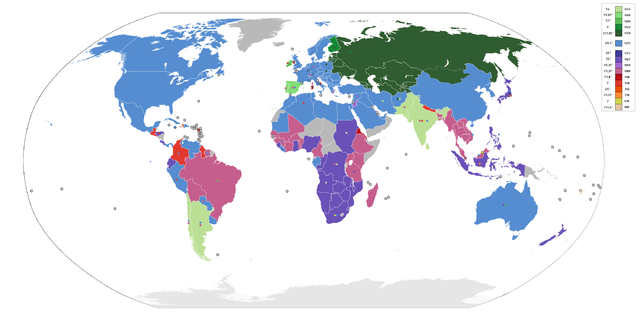 |
This is a file from the Wikimedia Commons. Information from its description page there is shown below.
Commons is a freely licensed media file repository. You can help.
|
 |
File:Rail gauge world.svg is a vector version of this file.
It should be used in place of this raster image when superior.
File:Rail gauge world.png  File:Rail gauge world.svg
For more information about vector graphics, read about Commons transition to SVG.
There is also information about MediaWiki's support of SVG images.
|
|
Summary
| DescriptionRail gauge world.png |
English: Shows the gauge which is currently most used in each country (main colour), with other significant gauges used depicted as small squares on top of the main colour. Grey indicates no railways.
|
| Date |
27 November 2006 |
| Source |
Made using the list on CIA Factbook railways and Seabhcan's railmap. Uses File:BlankMap-World6.svg |
| Author |
Own work |
Key
Feet and inches on the left, millimetres on the right. Green colours are broad gauge; light blue is standard gauge, used in Europe, Americas, China and Australia; other colours narrow gauge or no rail networks; dark green is Soviet broad gauge; light green is Indian broad gauge.

Licensing
I, the copyright holder of this work, hereby publish it under the following license:
 |
Permission is granted to copy, distribute and/or modify this document under the terms of the GNU Free Documentation License, Version 1.2 or any later version published by the Free Software Foundation; with no Invariant Sections, no Front-Cover Texts, and no Back-Cover Texts. A copy of the license is included in the section entitled GNU Free Documentation License. http://www.gnu.org/copyleft/fdl.htmlGFDLGNU Free Documentation Licensetruetrue
|
|
File usage
The following pages on Schools Wikipedia link to this image (list may be incomplete):
This file contains additional information, probably added from the digital camera or scanner used to create or digitize it. If the file has been modified from its original state, some details may not fully reflect the modified file.
SOS Childrens Villages has brought Wikipedia to the classroom. SOS Children's Villages is there for the children in our care until they are ready for independence. Have you thought about sponsoring a child?






